Pathologist Resume Examples
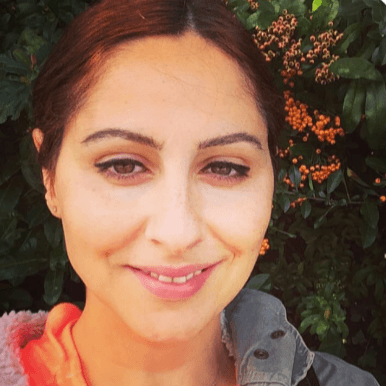
Jul 18, 2024
|
12 min read
Putting your skills under the microscope: A step-by-step guide to crafting a pathologist resume that gets you noticed and hired.
Rated by 348 people
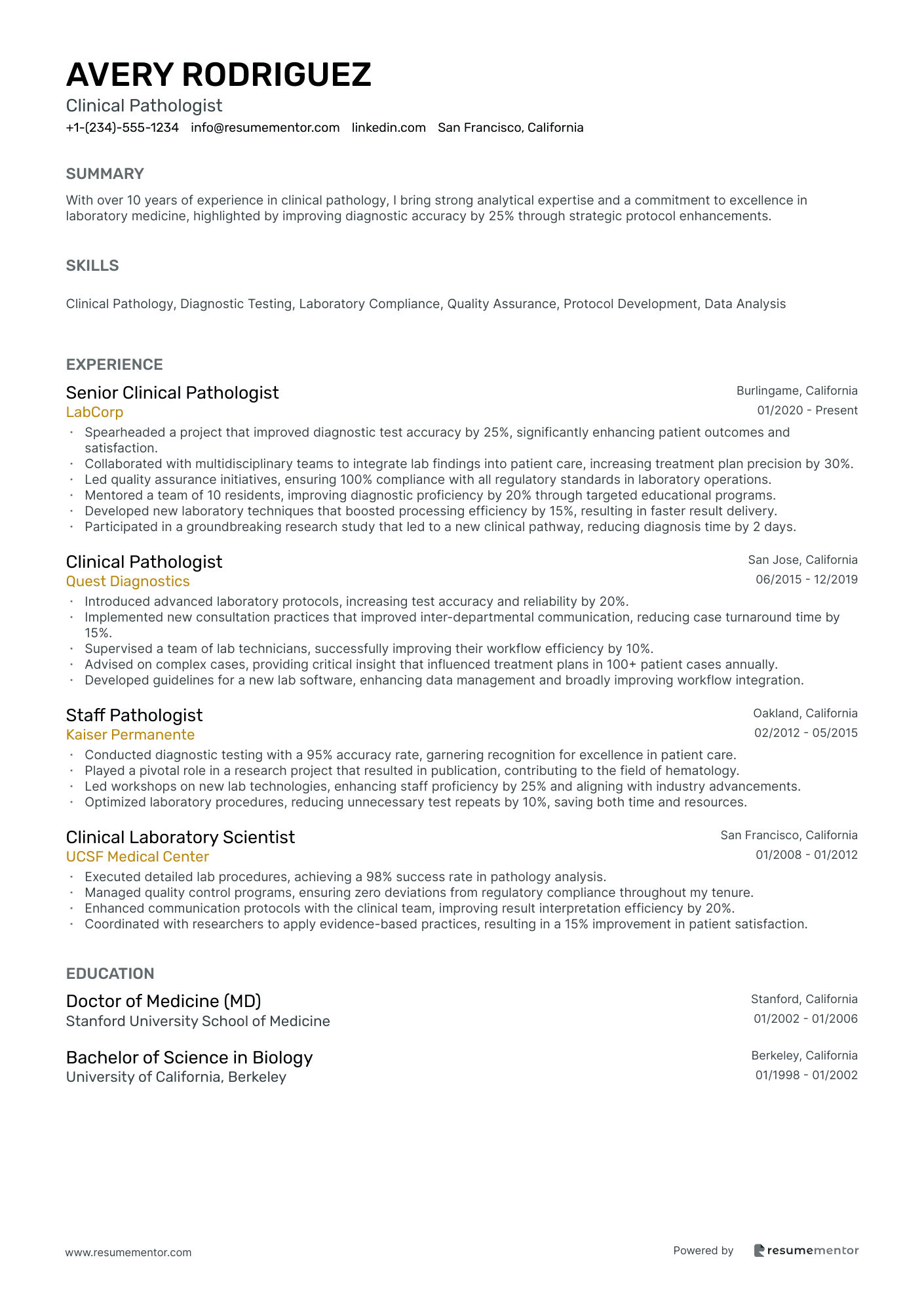
Clinical Pathologist

Hematopathologist
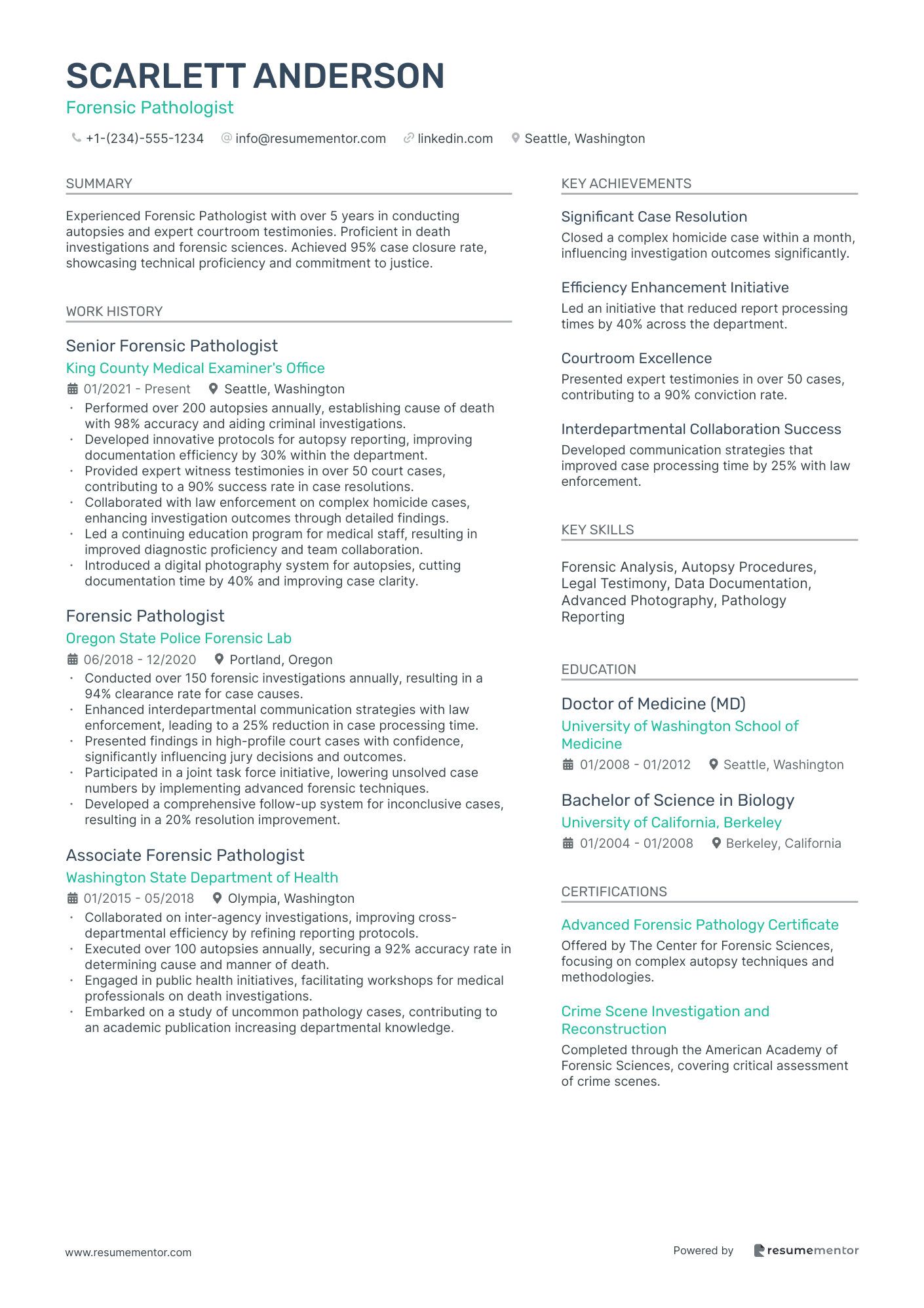
Forensic Pathologist
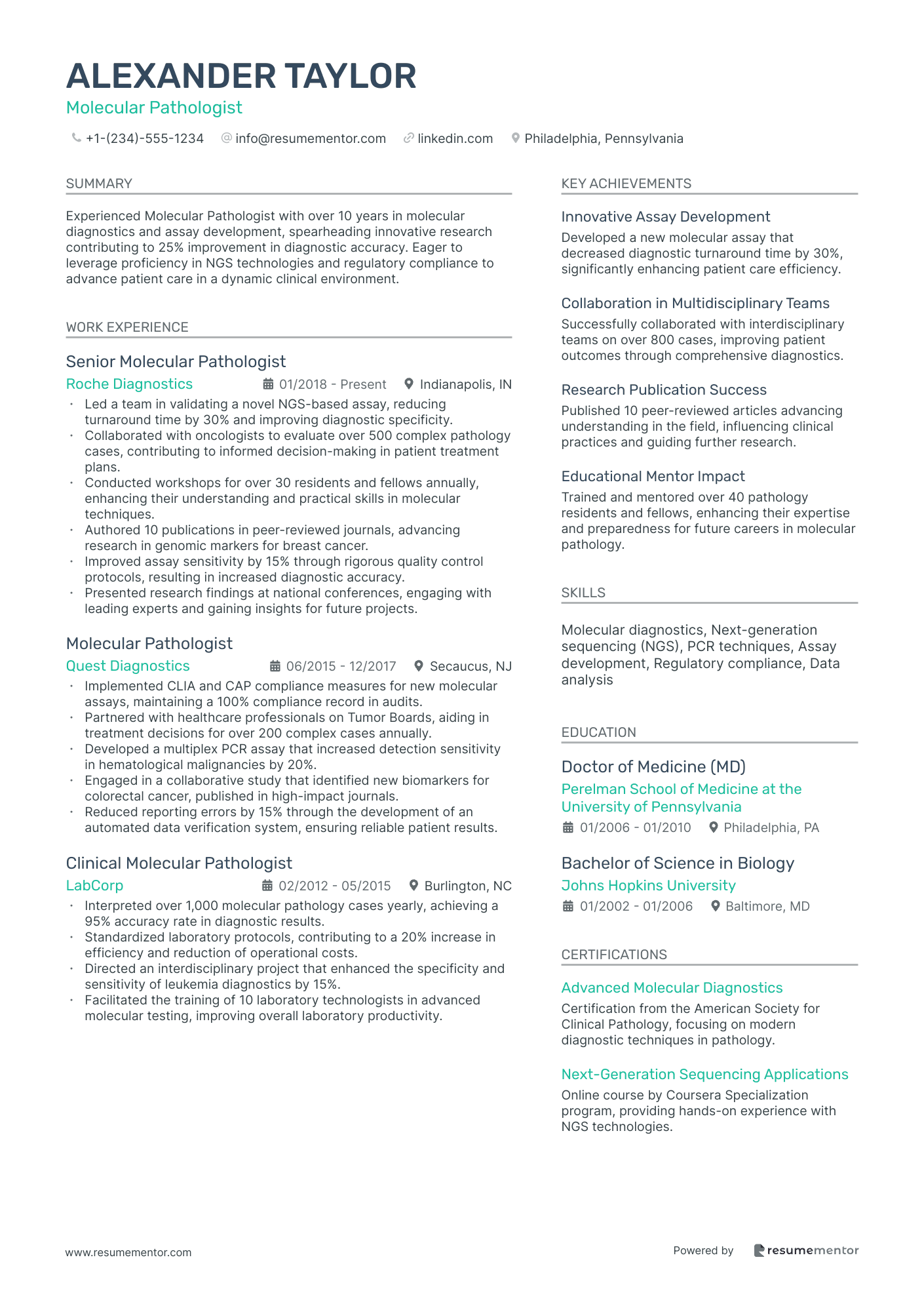
Molecular Pathologist
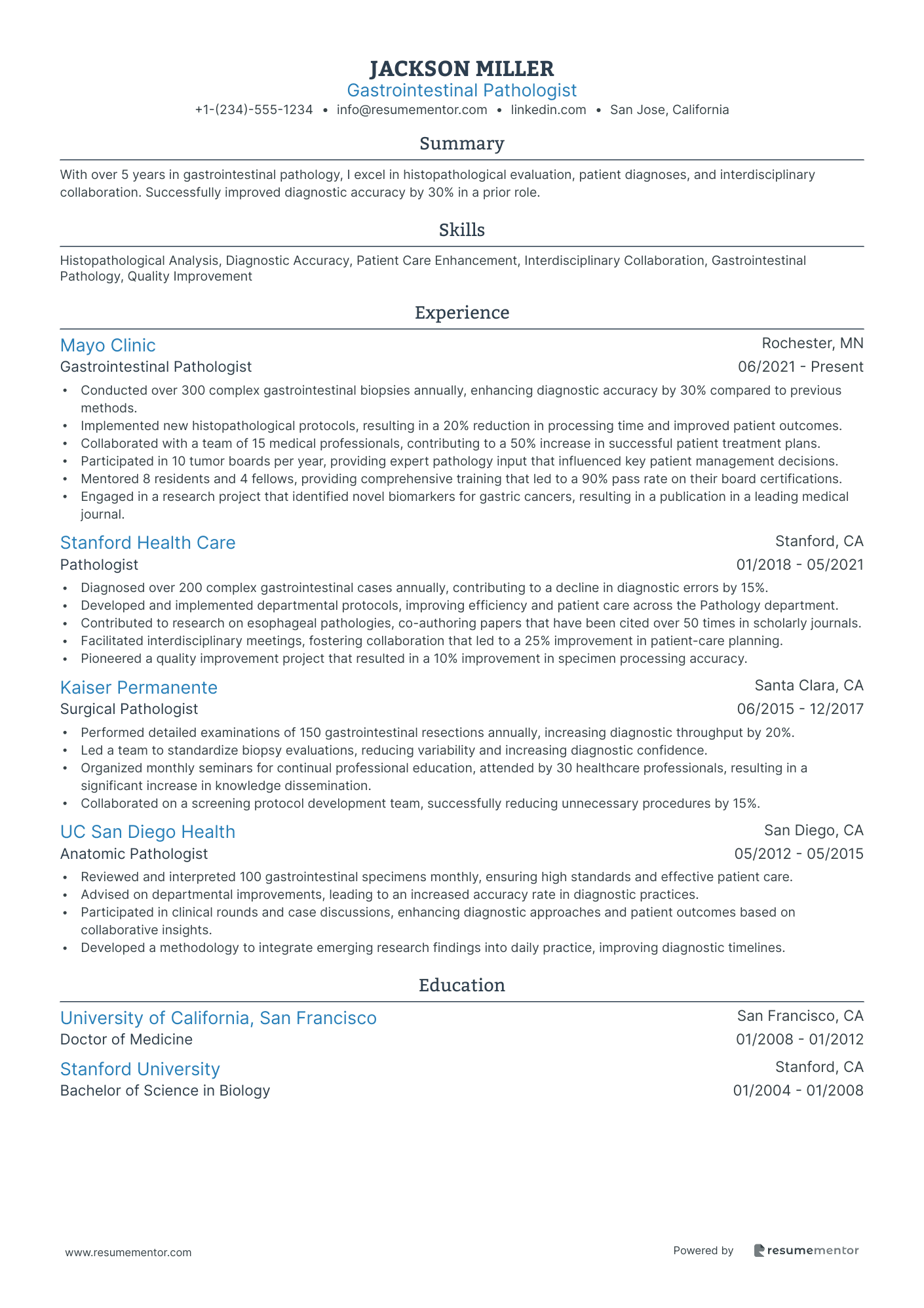
Gastrointestinal Pathologist
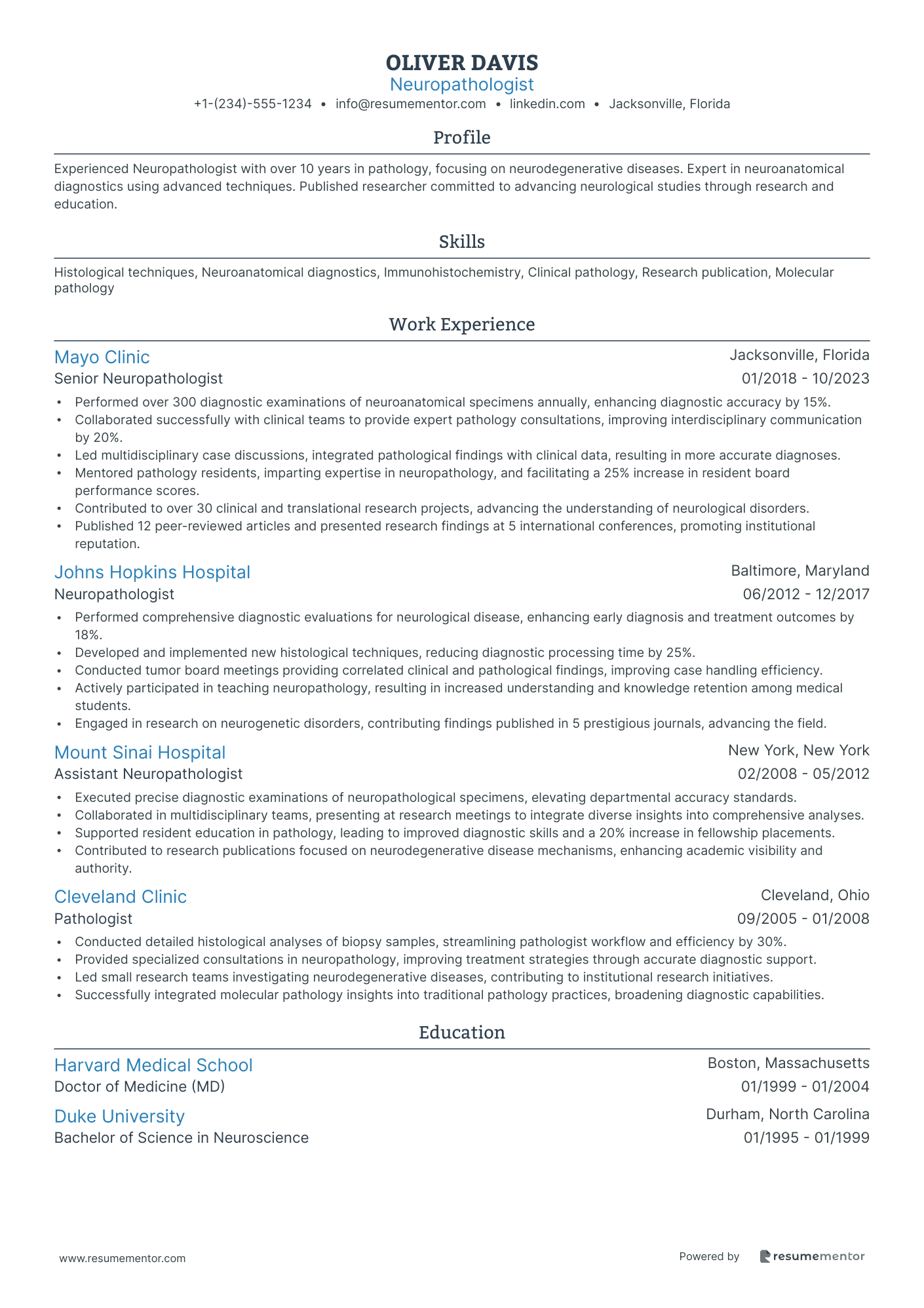
Neuropathologist
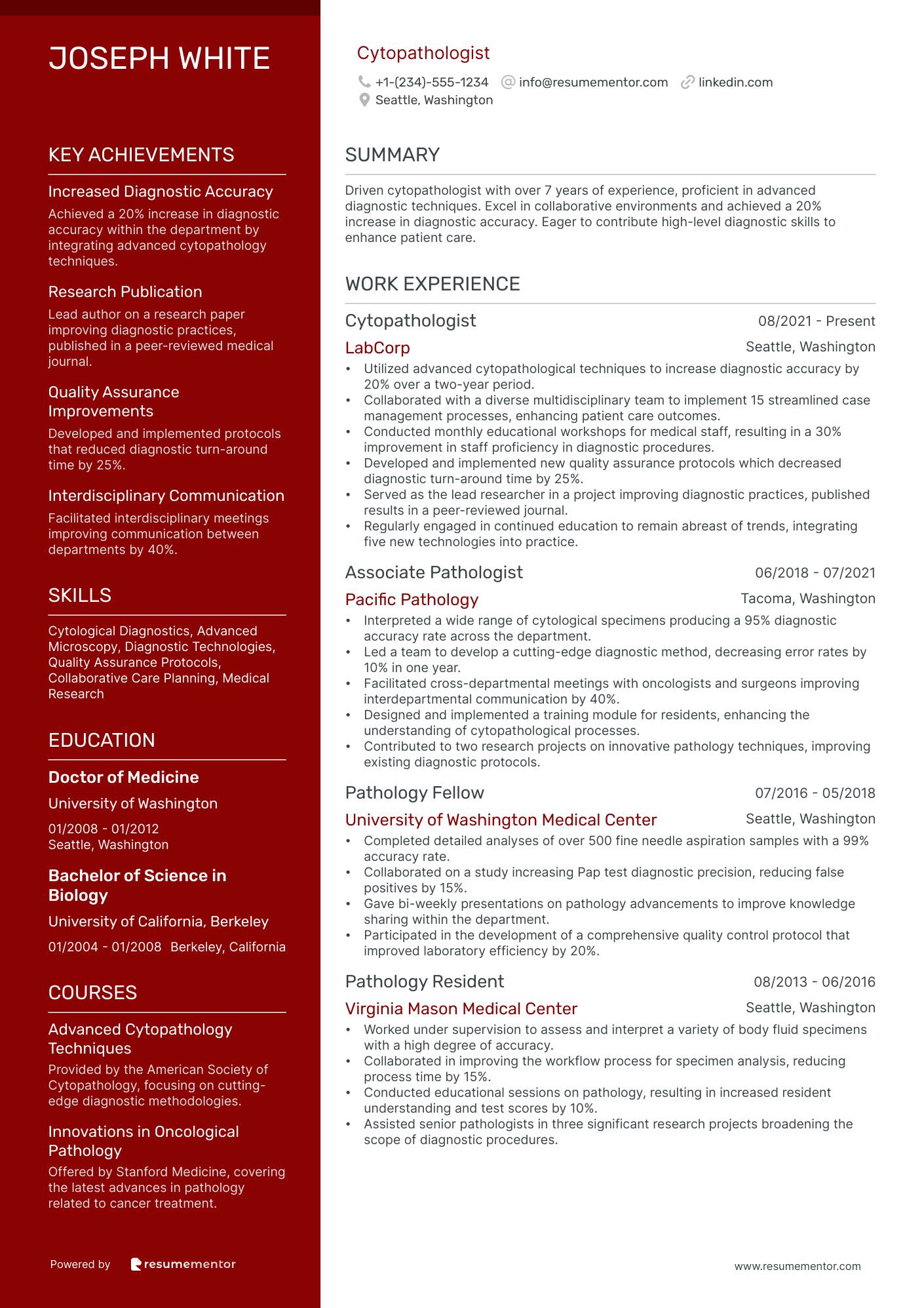
Cytopathologist
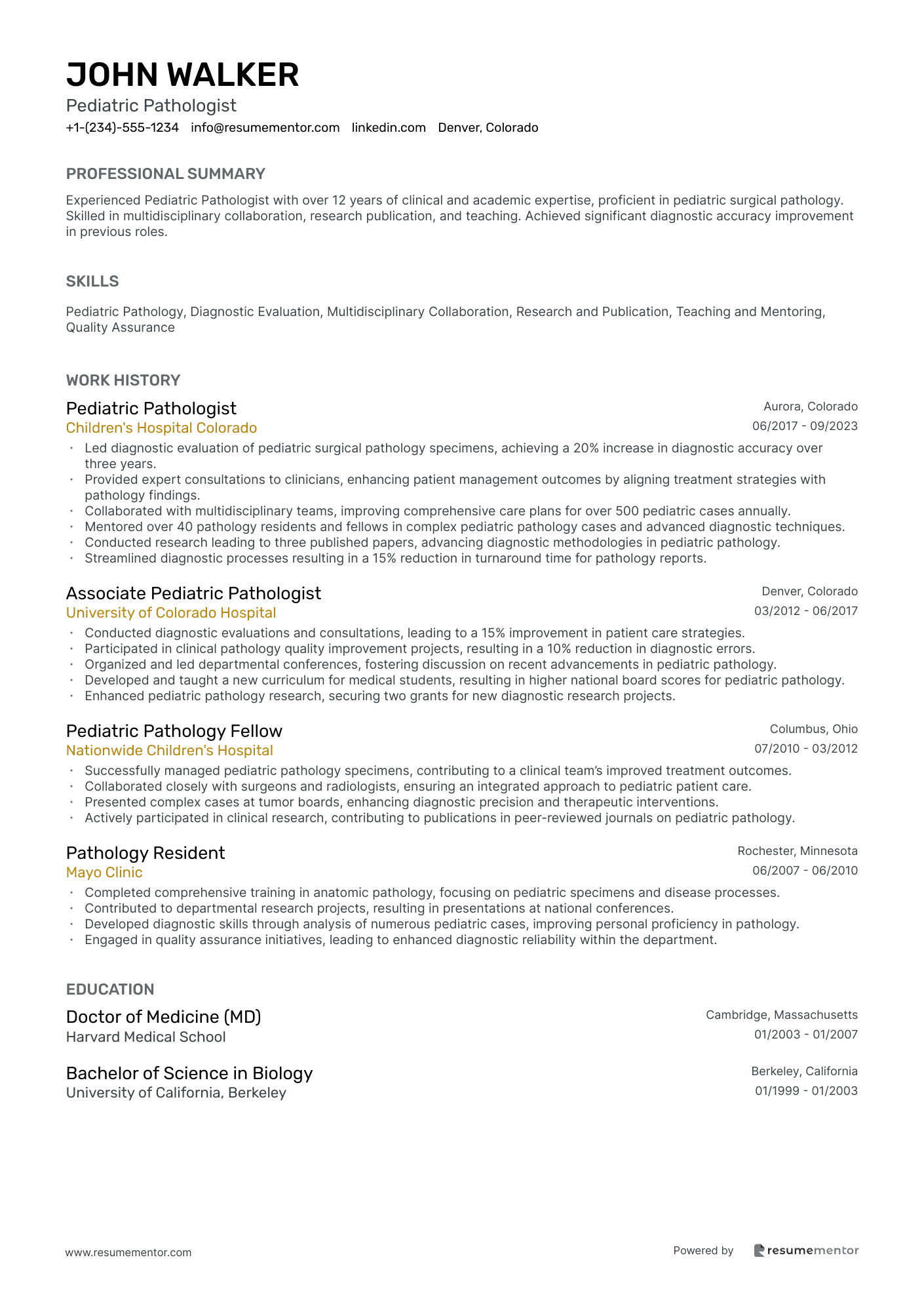
Pediatric Pathologist
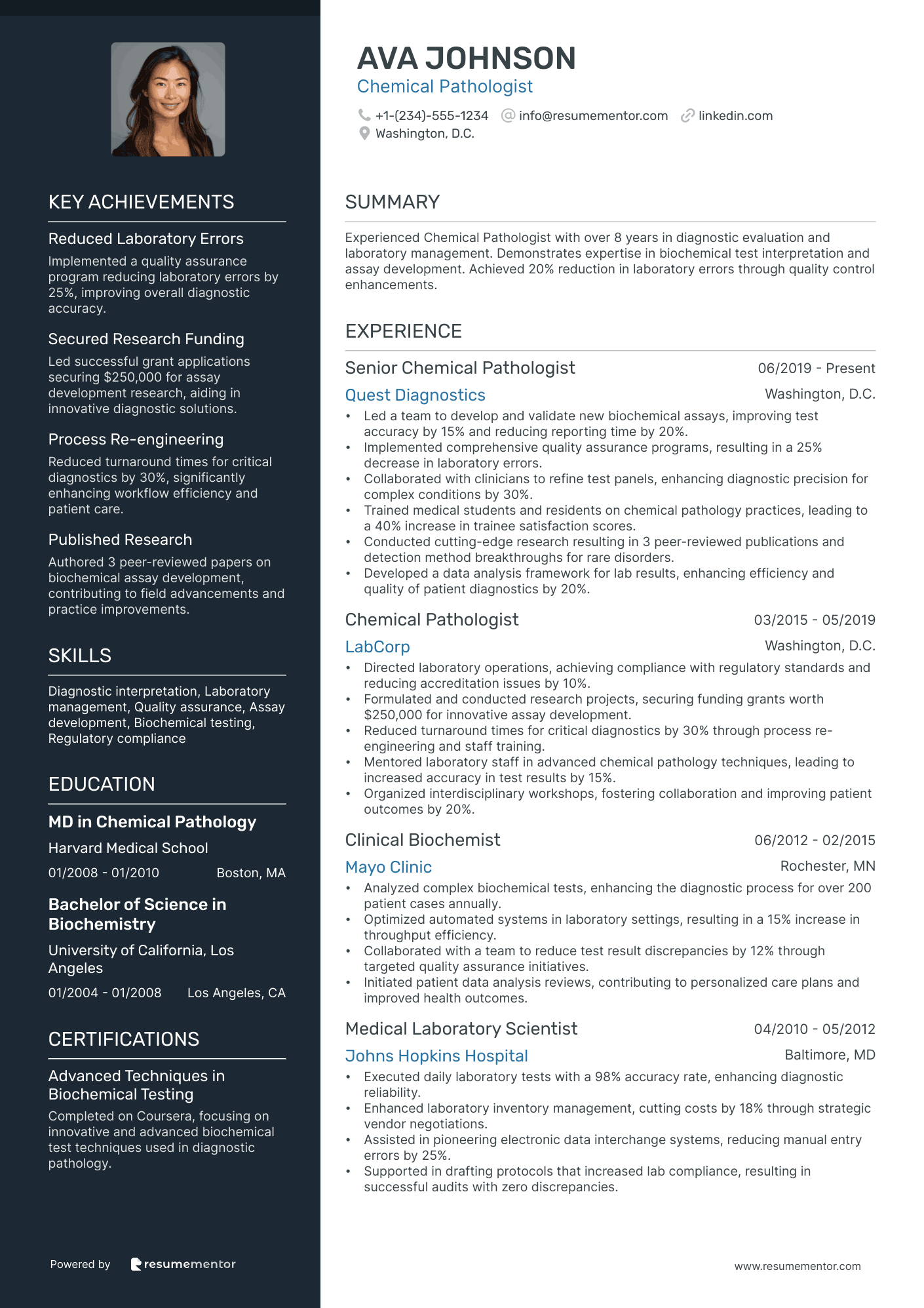
Chemical Pathologist

Clinical Pathologist resume sample
- •Spearheaded a project that improved diagnostic test accuracy by 25%, significantly enhancing patient outcomes and satisfaction.
- •Collaborated with multidisciplinary teams to integrate lab findings into patient care, increasing treatment plan precision by 30%.
- •Led quality assurance initiatives, ensuring 100% compliance with all regulatory standards in laboratory operations.
- •Mentored a team of 10 residents, improving diagnostic proficiency by 20% through targeted educational programs.
- •Developed new laboratory techniques that boosted processing efficiency by 15%, resulting in faster result delivery.
- •Participated in a groundbreaking research study that led to a new clinical pathway, reducing diagnosis time by 2 days.
- •Introduced advanced laboratory protocols, increasing test accuracy and reliability by 20%.
- •Implemented new consultation practices that improved inter-departmental communication, reducing case turnaround time by 15%.
- •Supervised a team of lab technicians, successfully improving their workflow efficiency by 10%.
- •Advised on complex cases, providing critical insight that influenced treatment plans in 100+ patient cases annually.
- •Developed guidelines for a new lab software, enhancing data management and broadly improving workflow integration.
- •Conducted diagnostic testing with a 95% accuracy rate, garnering recognition for excellence in patient care.
- •Played a pivotal role in a research project that resulted in publication, contributing to the field of hematology.
- •Led workshops on new lab technologies, enhancing staff proficiency by 25% and aligning with industry advancements.
- •Optimized laboratory procedures, reducing unnecessary test repeats by 10%, saving both time and resources.
- •Executed detailed lab procedures, achieving a 98% success rate in pathology analysis.
- •Managed quality control programs, ensuring zero deviations from regulatory compliance throughout my tenure.
- •Enhanced communication protocols with the clinical team, improving result interpretation efficiency by 20%.
- •Coordinated with researchers to apply evidence-based practices, resulting in a 15% improvement in patient satisfaction.
Hematopathologist resume sample
- •Led a team to improve diagnostic accuracy by 20% through optimizing bone marrow biopsy analysis techniques and implementing best practices.
- •Collaborated with interdisciplinary teams resulting in the development of personalized treatment plans for over 300 patients annually.
- •Reduced report turnaround time by 25% by streamlining the collaboration processes with clinical colleagues and implementing new reporting templates.
- •Pioneered a robust quality assurance program, resulting in a 15% enhancement in laboratory error mitigation.
- •Contributed to 5 research publications in high-impact journals, focusing on new advancements in hematological diagnostics.
- •Mentored 10 medical trainees in hematopathology, fostering skill development and enhancing lab operational knowledge.
- •Managed the interpretation of over 1,000 hematopathology cases each year, driving significant improvements in diagnostic proficiency.
- •Played a key role in multidisciplinary team meetings, contributing insights that enhanced patient outcomes across various complex cases.
- •Developed a training module that increased proficiency in lymph node biopsy analyses by 30% among junior pathologists.
- •Implemented state-of-the-art hematological techniques, reducing diagnostic errors by 15% within the first year.
- •Conducted seminars on recent advancements in hematopathology, engaging over 100 healthcare professionals.
- •Analyzed peripheral blood smears resulting in a 20% increase in early diagnosis of hematological disorders.
- •Led collaborative research with the oncology department, resulting in two published papers on innovative treatment methodologies.
- •Coordinated educational workshops for laboratory staff, enhancing competency in handling advanced diagnostic tools.
- •Initiated a lab-wide shift towards digital pathology, significantly improving data sharing and analysis efficiency.
- •Provided diagnostic expertise in over 800 hematopathology cases annually, contributing to improved patient management strategies.
- •Participated in a collaborative effort to evaluate new diagnostic equipment, leading to a 10% improvement in lab efficiency.
- •Contributed to a team that developed a new protocol for bone marrow biopsy reporting, enhancing result accuracy and timeliness.
- •Delivered educational talks at regional medical conferences, extending awareness of advanced hematopathological practices.
Forensic Pathologist resume sample
- •Performed over 200 autopsies annually, establishing cause of death with 98% accuracy and aiding criminal investigations.
- •Developed innovative protocols for autopsy reporting, improving documentation efficiency by 30% within the department.
- •Provided expert witness testimonies in over 50 court cases, contributing to a 90% success rate in case resolutions.
- •Collaborated with law enforcement on complex homicide cases, enhancing investigation outcomes through detailed findings.
- •Led a continuing education program for medical staff, resulting in improved diagnostic proficiency and team collaboration.
- •Introduced a digital photography system for autopsies, cutting documentation time by 40% and improving case clarity.
- •Conducted over 150 forensic investigations annually, resulting in a 94% clearance rate for case causes.
- •Enhanced interdepartmental communication strategies with law enforcement, leading to a 25% reduction in case processing time.
- •Presented findings in high-profile court cases with confidence, significantly influencing jury decisions and outcomes.
- •Participated in a joint task force initiative, lowering unsolved case numbers by implementing advanced forensic techniques.
- •Developed a comprehensive follow-up system for inconclusive cases, resulting in a 20% resolution improvement.
- •Collaborated on inter-agency investigations, improving cross-departmental efficiency by refining reporting protocols.
- •Executed over 100 autopsies annually, securing a 92% accuracy rate in determining cause and manner of death.
- •Engaged in public health initiatives, facilitating workshops for medical professionals on death investigations.
- •Embarked on a study of uncommon pathology cases, contributing to an academic publication increasing departmental knowledge.
- •Completed over 500 hours of supervised autopsies, developing foundational skills in forensic pathology procedures.
- •Supported forensic teams in investigation processes, improving case analysis and reporting capabilities.
- •Participated in multidisciplinary research, gaining exposure to diverse pathology methodologies.
- •Assisted in the development of new training modules for residents, increasing program effectiveness and participant satisfaction.
Molecular Pathologist resume sample
- •Led a team in validating a novel NGS-based assay, reducing turnaround time by 30% and improving diagnostic specificity.
- •Collaborated with oncologists to evaluate over 500 complex pathology cases, contributing to informed decision-making in patient treatment plans.
- •Conducted workshops for over 30 residents and fellows annually, enhancing their understanding and practical skills in molecular techniques.
- •Authored 10 publications in peer-reviewed journals, advancing research in genomic markers for breast cancer.
- •Improved assay sensitivity by 15% through rigorous quality control protocols, resulting in increased diagnostic accuracy.
- •Presented research findings at national conferences, engaging with leading experts and gaining insights for future projects.
- •Implemented CLIA and CAP compliance measures for new molecular assays, maintaining a 100% compliance record in audits.
- •Partnered with healthcare professionals on Tumor Boards, aiding in treatment decisions for over 200 complex cases annually.
- •Developed a multiplex PCR assay that increased detection sensitivity in hematological malignancies by 20%.
- •Engaged in a collaborative study that identified new biomarkers for colorectal cancer, published in high-impact journals.
- •Reduced reporting errors by 15% through the development of an automated data verification system, ensuring reliable patient results.
- •Interpreted over 1,000 molecular pathology cases yearly, achieving a 95% accuracy rate in diagnostic results.
- •Standardized laboratory protocols, contributing to a 20% increase in efficiency and reduction of operational costs.
- •Directed an interdisciplinary project that enhanced the specificity and sensitivity of leukemia diagnostics by 15%.
- •Facilitated the training of 10 laboratory technologists in advanced molecular testing, improving overall laboratory productivity.
- •Contributed to the development of a novel diagnostic tool for genetic disorders, accelerating diagnosis times by 25%.
- •Collaborated with research teams on a study that explored genetic mutations, resulting in publication in a lead journal.
- •Assisted in quality assurance processes, leading to a 10% improvement in laboratory error rates over one year.
- •Participated in departmental seminars to enhance understanding of advanced molecular diagnostics among peers.
Gastrointestinal Pathologist resume sample
- •Conducted over 300 complex gastrointestinal biopsies annually, enhancing diagnostic accuracy by 30% compared to previous methods.
- •Implemented new histopathological protocols, resulting in a 20% reduction in processing time and improved patient outcomes.
- •Collaborated with a team of 15 medical professionals, contributing to a 50% increase in successful patient treatment plans.
- •Participated in 10 tumor boards per year, providing expert pathology input that influenced key patient management decisions.
- •Mentored 8 residents and 4 fellows, providing comprehensive training that led to a 90% pass rate on their board certifications.
- •Engaged in a research project that identified novel biomarkers for gastric cancers, resulting in a publication in a leading medical journal.
- •Diagnosed over 200 complex gastrointestinal cases annually, contributing to a decline in diagnostic errors by 15%.
- •Developed and implemented departmental protocols, improving efficiency and patient care across the Pathology department.
- •Contributed to research on esophageal pathologies, co-authoring papers that have been cited over 50 times in scholarly journals.
- •Facilitated interdisciplinary meetings, fostering collaboration that led to a 25% improvement in patient-care planning.
- •Pioneered a quality improvement project that resulted in a 10% improvement in specimen processing accuracy.
- •Performed detailed examinations of 150 gastrointestinal resections annually, increasing diagnostic throughput by 20%.
- •Led a team to standardize biopsy evaluations, reducing variability and increasing diagnostic confidence.
- •Organized monthly seminars for continual professional education, attended by 30 healthcare professionals, resulting in a significant increase in knowledge dissemination.
- •Collaborated on a screening protocol development team, successfully reducing unnecessary procedures by 15%.
- •Reviewed and interpreted 100 gastrointestinal specimens monthly, ensuring high standards and effective patient care.
- •Advised on departmental improvements, leading to an increased accuracy rate in diagnostic practices.
- •Participated in clinical rounds and case discussions, enhancing diagnostic approaches and patient outcomes based on collaborative insights.
- •Developed a methodology to integrate emerging research findings into daily practice, improving diagnostic timelines.
Neuropathologist resume sample
- •Performed over 300 diagnostic examinations of neuroanatomical specimens annually, enhancing diagnostic accuracy by 15%.
- •Collaborated successfully with clinical teams to provide expert pathology consultations, improving interdisciplinary communication by 20%.
- •Led multidisciplinary case discussions, integrated pathological findings with clinical data, resulting in more accurate diagnoses.
- •Mentored pathology residents, imparting expertise in neuropathology, and facilitating a 25% increase in resident board performance scores.
- •Contributed to over 30 clinical and translational research projects, advancing the understanding of neurological disorders.
- •Published 12 peer-reviewed articles and presented research findings at 5 international conferences, promoting institutional reputation.
- •Performed comprehensive diagnostic evaluations for neurological disease, enhancing early diagnosis and treatment outcomes by 18%.
- •Developed and implemented new histological techniques, reducing diagnostic processing time by 25%.
- •Conducted tumor board meetings providing correlated clinical and pathological findings, improving case handling efficiency.
- •Actively participated in teaching neuropathology, resulting in increased understanding and knowledge retention among medical students.
- •Engaged in research on neurogenetic disorders, contributing findings published in 5 prestigious journals, advancing the field.
- •Executed precise diagnostic examinations of neuropathological specimens, elevating departmental accuracy standards.
- •Collaborated in multidisciplinary teams, presenting at research meetings to integrate diverse insights into comprehensive analyses.
- •Supported resident education in pathology, leading to improved diagnostic skills and a 20% increase in fellowship placements.
- •Contributed to research publications focused on neurodegenerative disease mechanisms, enhancing academic visibility and authority.
- •Conducted detailed histological analyses of biopsy samples, streamlining pathologist workflow and efficiency by 30%.
- •Provided specialized consultations in neuropathology, improving treatment strategies through accurate diagnostic support.
- •Led small research teams investigating neurodegenerative diseases, contributing to institutional research initiatives.
- •Successfully integrated molecular pathology insights into traditional pathology practices, broadening diagnostic capabilities.
Cytopathologist resume sample
- •Utilized advanced cytopathological techniques to increase diagnostic accuracy by 20% over a two-year period.
- •Collaborated with a diverse multidisciplinary team to implement 15 streamlined case management processes, enhancing patient care outcomes.
- •Conducted monthly educational workshops for medical staff, resulting in a 30% improvement in staff proficiency in diagnostic procedures.
- •Developed and implemented new quality assurance protocols which decreased diagnostic turn-around time by 25%.
- •Served as the lead researcher in a project improving diagnostic practices, published results in a peer-reviewed journal.
- •Regularly engaged in continued education to remain abreast of trends, integrating five new technologies into practice.
- •Interpreted a wide range of cytological specimens producing a 95% diagnostic accuracy rate across the department.
- •Led a team to develop a cutting-edge diagnostic method, decreasing error rates by 10% in one year.
- •Facilitated cross-departmental meetings with oncologists and surgeons improving interdepartmental communication by 40%.
- •Designed and implemented a training module for residents, enhancing the understanding of cytopathological processes.
- •Contributed to two research projects on innovative pathology techniques, improving existing diagnostic protocols.
- •Completed detailed analyses of over 500 fine needle aspiration samples with a 99% accuracy rate.
- •Collaborated on a study increasing Pap test diagnostic precision, reducing false positives by 15%.
- •Gave bi-weekly presentations on pathology advancements to improve knowledge sharing within the department.
- •Participated in the development of a comprehensive quality control protocol that improved laboratory efficiency by 20%.
- •Worked under supervision to assess and interpret a variety of body fluid specimens with a high degree of accuracy.
- •Collaborated in improving the workflow process for specimen analysis, reducing process time by 15%.
- •Conducted educational sessions on pathology, resulting in increased resident understanding and test scores by 10%.
- •Assisted senior pathologists in three significant research projects broadening the scope of diagnostic procedures.
Pediatric Pathologist resume sample
- •Led diagnostic evaluation of pediatric surgical pathology specimens, achieving a 20% increase in diagnostic accuracy over three years.
- •Provided expert consultations to clinicians, enhancing patient management outcomes by aligning treatment strategies with pathology findings.
- •Collaborated with multidisciplinary teams, improving comprehensive care plans for over 500 pediatric cases annually.
- •Mentored over 40 pathology residents and fellows in complex pediatric pathology cases and advanced diagnostic techniques.
- •Conducted research leading to three published papers, advancing diagnostic methodologies in pediatric pathology.
- •Streamlined diagnostic processes resulting in a 15% reduction in turnaround time for pathology reports.
- •Conducted diagnostic evaluations and consultations, leading to a 15% improvement in patient care strategies.
- •Participated in clinical pathology quality improvement projects, resulting in a 10% reduction in diagnostic errors.
- •Organized and led departmental conferences, fostering discussion on recent advancements in pediatric pathology.
- •Developed and taught a new curriculum for medical students, resulting in higher national board scores for pediatric pathology.
- •Enhanced pediatric pathology research, securing two grants for new diagnostic research projects.
- •Successfully managed pediatric pathology specimens, contributing to a clinical team’s improved treatment outcomes.
- •Collaborated closely with surgeons and radiologists, ensuring an integrated approach to pediatric patient care.
- •Presented complex cases at tumor boards, enhancing diagnostic precision and therapeutic interventions.
- •Actively participated in clinical research, contributing to publications in peer-reviewed journals on pediatric pathology.
- •Completed comprehensive training in anatomic pathology, focusing on pediatric specimens and disease processes.
- •Contributed to departmental research projects, resulting in presentations at national conferences.
- •Developed diagnostic skills through analysis of numerous pediatric cases, improving personal proficiency in pathology.
- •Engaged in quality assurance initiatives, leading to enhanced diagnostic reliability within the department.
Chemical Pathologist resume sample
- •Led a team to develop and validate new biochemical assays, improving test accuracy by 15% and reducing reporting time by 20%.
- •Implemented comprehensive quality assurance programs, resulting in a 25% decrease in laboratory errors.
- •Collaborated with clinicians to refine test panels, enhancing diagnostic precision for complex conditions by 30%.
- •Trained medical students and residents on chemical pathology practices, leading to a 40% increase in trainee satisfaction scores.
- •Conducted cutting-edge research resulting in 3 peer-reviewed publications and detection method breakthroughs for rare disorders.
- •Developed a data analysis framework for lab results, enhancing efficiency and quality of patient diagnostics by 20%.
- •Directed laboratory operations, achieving compliance with regulatory standards and reducing accreditation issues by 10%.
- •Formulated and conducted research projects, securing funding grants worth $250,000 for innovative assay development.
- •Reduced turnaround times for critical diagnostics by 30% through process re-engineering and staff training.
- •Mentored laboratory staff in advanced chemical pathology techniques, leading to increased accuracy in test results by 15%.
- •Organized interdisciplinary workshops, fostering collaboration and improving patient outcomes by 20%.
- •Analyzed complex biochemical tests, enhancing the diagnostic process for over 200 patient cases annually.
- •Optimized automated systems in laboratory settings, resulting in a 15% increase in throughput efficiency.
- •Collaborated with a team to reduce test result discrepancies by 12% through targeted quality assurance initiatives.
- •Initiated patient data analysis reviews, contributing to personalized care plans and improved health outcomes.
- •Executed daily laboratory tests with a 98% accuracy rate, enhancing diagnostic reliability.
- •Enhanced laboratory inventory management, cutting costs by 18% through strategic vendor negotiations.
- •Assisted in pioneering electronic data interchange systems, reducing manual entry errors by 25%.
- •Supported in drafting protocols that increased lab compliance, resulting in successful audits with zero discrepancies.
Crafting a pathologist resume can feel like solving a complex puzzle, much like your expertise in diagnosing diseases. While you excel at uncovering medical mysteries, translating those intricate skills onto a single sheet of paper is a unique challenge. Your academic achievements and hands-on experience are invaluable, but presenting them concisely and effectively is crucial to your job search.
In the competitive medical field, a clear and compelling resume is essential for opening doors to new opportunities. It's all about ensuring that your keen eye for detail and precision in pathology catch the attention of potential employers. To do this, you need to highlight your ability to manage laboratory operations, diagnose disorders, and seamlessly collaborate with healthcare teams.
A structured approach can simplify this process, and that's where resume templates become invaluable. They provide a polished framework to organize your credentials, ensuring that each crucial aspect of your experience stands out. These templates help you make a distinctive and memorable first impression right from the start.
Aligning your resume with what hiring managers seek can be pivotal. You want your document to be more than just informative; it should capture the unique contributions you bring to the table. Following this guide will equip you to craft a resume that not only highlights your qualifications but also engages potential employers effortlessly.
Key Takeaways
- Crafting a pathologist resume should highlight your medical expertise, diagnostic skills, and ability to manage laboratory operations effectively.
- Utilizing resume templates can provide a structured framework to effectively present your qualifications and make a memorable impression.
- A resume should align with hiring managers' expectations, focusing on both your unique contributions and technical skills such as histopathology and cytopathology.
- Selecting a chronological resume format can help present your career path logically, emphasizing growing expertise and professional accomplishments.
- A resume summary should encapsulate your experience and specialized skills, including any relevant certifications, to stand out in the job market.
What to focus on when writing your pathologist resume
Your pathologist resume should underscore your medical expertise and diagnostic skills. For contact information, include your full name, phone number, email, and LinkedIn profile—make sure these are prominent and current, as this is the first impression you'll make. Next, craft a compelling professional summary that provides an overview of your experience and specialties, such as specific fields like forensic or clinical pathology, along with notable accomplishments that set you apart.
How to structure your pathologist resume
- **Contact Information**: Include your full name, phone number, email, and LinkedIn profile to ensure they are easy to find and up to date.
- **Professional Summary**: Craft an engaging overview of your experience and pathologist specialties, along with key accomplishments that distinguish you from others.
- **Medical Expertise**: Detail your experience with diagnostic tests, autopsies, and relevant laboratory techniques, showcasing your technical skills in pathology.
- **Education**: List your degrees, certifications, and fellowships, including institutions’ names and completion dates to emphasize your educational background in pathology.
- **Work Experience**: Highlight roles in clinical diagnoses, emphasize significant research contributions, and list achievements like improved diagnostic accuracy rates.
- **Skills**: Focus on areas like histopathology, cytopathology, and proficiency with specialized laboratory technology to demonstrate your capabilities.
This structure sets you up for success by painting a complete picture of your qualifications. Below, we will cover each section in more depth to help you craft each part of your resume effectively.
Which resume format to choose
Creating a professional pathologist resume begins with selecting the right format. Opt for a chronological resume, as it allows you to present your career path in a clear, logical order. This format is particularly effective for highlighting your growing expertise and accomplishments in the field of pathology, making it easier for potential employers to track your progress and the impact you have made in previous roles.
When it comes to fonts, choosing modern and clean options can subtly enhance the overall look of your resume. Consider using Raleway for its clean lines that enhance the readability of important details. Lato's modern style communicates a sense of professionalism and is easy on the eyes, while Montserrat stands out with its sleek, contemporary flair. These font choices help maintain a polished look that supports, rather than distracts from, your valuable content.
Always save your resume as a PDF. This ensures that the formatting stays intact, which is vital for maintaining your resume's professional appearance across various devices. PDFs prevent your hard work from displaying differently due to software variations, ensuring that your resume looks the same on any computer or mobile device.
Setting your margins to one inch all around creates a neat and organized layout, helping to keep the content from feeling cramped. This practice also allows your experience and qualifications to stand out, supported by ample white space that guides the reader’s eye naturally through the information.
By integrating each of these elements, you build a pathologist resume that not only effectively showcases your skills and experience but also demonstrates your attention to detail and commitment to professionalism in the medical field.
How to write a quantifiable resume experience section
- •Cut test result turnaround time by 25% by streamlining lab processes.
- •Boosted department efficiency by 30% with new digital pathology technologies, reaching a record high in output.
- •Led a team of 15 pathologists, securing quality assurance accreditation for the hospital.
- •Published 12 peer-reviewed articles in leading journals, enhancing the hospital's research profile.
Your pathologist resume's experience section should flow like a narrative, highlighting your professional journey and impact in a clear and cohesive manner. Start with your most recent roles and include impactful, quantifiable achievements, ensuring each bullet point builds on your story of success. Look back 10-15 years to include relevant positions that showcase your growth and contributions. Incorporate the job ad's language to make your resume resonate. Use strong action words like "led," "implemented," and "authored" to seamlessly connect your tasks with outcomes. This approach not only demonstrates your expertise but also paints a vivid picture of how you can contribute to a new role.
Project-Focused resume experience section
A project-focused pathologist resume experience section should seamlessly integrate your key projects to illustrate the value you bring. Start by selecting projects that align with your prospective job role, emphasizing your expertise and the tangible impact of your work. Clearly outline the problem you addressed, the actions you implemented, and the results achieved to help potential employers see your ability to deliver outcomes that matter.
Within your bullet points, begin with strong action verbs and include measurable results to highlight your achievements. Show how your projects have advanced diagnostic processes, improved patient outcomes, and contributed to important research. Keep your language simple and avoid jargon, ensuring that your accomplishments are easily understood. By linking your individual successes to the broader goals of each project, you demonstrate both your skills and your ability to collaborate effectively.
Lead Pathologist
Innovative Diagnostics Inc.
January 2020 - Present
- Led a team in creating a diagnostic tool that boosted cancer detection rates by 20%.
- Worked with a multidisciplinary team to publish findings in a top medical journal.
- Implemented a quality control protocol reducing error rates by 15% in the first year.
- Presented new biopsy techniques at a national conference.
Leadership-Focused resume experience section
A leadership-focused pathologist resume experience section should highlight your ability to guide teams and drive change effectively. Begin by showcasing your leadership roles and weaving in specific achievements that stem from those roles. Using action-filled language will bring your experience to life as you describe how you successfully managed projects and led teams towards meaningful improvements. It’s essential to emphasize the outcomes of your leadership, such as increased efficiency or enhanced team performance, which can be validated with numerical data or specific results.
In the structured example below, your leadership skills are at the forefront, connecting each point to create an engaging narrative. The entries, with clearly defined job titles and responsibilities, underscore your capability to lead and inspire. Each bullet point is linked to the next, highlighting your significant influence and the tangible benefits of your leadership, painting a cohesive picture of your impact within the workplace.
Lead Pathologist
City Hospital
January 2015 - Present
- Spearheaded a cross-department initiative to improve lab procedures, successfully cutting test turnaround time by 20%, and fostering better teamwork.
- Mentored clinical staff, which not only led to a 30% boost in department staff retention but also created a stronger, more cohesive team.
- Developed a comprehensive training program, a key factor in increasing team productivity and diagnostic accuracy significantly.
- Led a strategic planning project that enhanced overall department efficiency, resulting in annual savings of $500K for the hospital.
Training and Development Focused resume experience section
A Training and Development Focused Pathologist resume experience section should effectively showcase your ability to enhance the skills of others in the medical field. Highlight achievements in training, mentoring, and developing personnel, emphasizing your role in leading educational initiatives and refining training programs. Your descriptions should clearly illustrate how your contributions have supported pathologist trainees, showing the real-world impact of your efforts on their growth and the overall efficiency of the training process.
It's essential to include measurable accomplishments, providing a concrete sense of your effectiveness. Mention any seminars, workshops, or mentorship programs you’ve led, and detail their outcomes to demonstrate your initiative and results-driven approach. This section should also reflect your collaborative nature and knack for breaking down complex information, ensuring it’s understandable and accessible. Incorporate relevant keywords naturally to align with the responsibilities and successes you aim to highlight, making your experience section both compelling and relevant.
Pathologist
ABC Medical Institute
June 2018 - Present
- Developed and implemented a trainee feedback system, boosting satisfaction scores by 20%.
- Organized quarterly workshops that enhanced trainee diagnostic skills, increasing efficiency by 15%.
- Mentored over 30 pathology trainees, achieving a 100% success rate in board certification exams.
- Collaborated with senior pathologists to redesign the training curriculum, leading to improved learning outcomes.
Skills-Focused resume experience section
A skills-focused pathologist resume experience section should effectively highlight the unique abilities that make you proficient in your role. Start by outlining your main responsibilities at the top, then use bullet points to bring your skills to life through real examples of your achievements. These achievements should clearly demonstrate what you have accomplished and what sets you apart from others in the field.
Detailing the technologies and methods you're skilled in helps illustrate your proficiency and how you apply them in practice. Describe how you've successfully diagnosed diseases and managed lab equipment, showcasing your technical and analytical prowess. Sharing innovative solutions or leadership experiences adds depth, while mentioning recognitions or certifications further builds your credibility. Through active and engaging language, you'll convey initiative and competence, painting a comprehensive picture of your professional capabilities.
Pathologist
City Medical Center
January 2018 - Present
- Developed and implemented new diagnostic protocols, increasing accuracy by 15%
- Led a team in managing over 1,000 samples monthly, ensuring timely reporting
- Trained junior pathologists in advanced histological techniques
- Collaborated with researchers on a study published in a renowned medical journal
Write your pathologist resume summary section
A pathologist-focused resume summary section should clearly highlight your expertise and experience in examining and diagnosing diseases. Crafting a strong resume summary is key to standing out in the job market. It’s like a snapshot at the top of your resume, outlining your qualifications and career highlights. For a pathologist, it’s essential to focus on your skills in diagnosing diseases and examining tissues, which are central to your role. Including your years of experience and any specialized skills you possess will add depth to your summary.
This example works well by clearly stating the pathologist's expertise and experience and highlighting specific skills and certifications that make you stand out. When you describe yourself in a resume summary, focusing on attributes like dedication, precision, and expertise can make a lasting impression. Adding details such as years of experience and specialization ensures that your summary is not just impactful but relevant.
Navigating the differences between a resume summary and other sections like the resume objective, profile, and summary of qualifications can be confusing, but understanding them is crucial. A resume summary provides a concise overview of your experience, while a resume objective speaks to your career goals, primarily for those new to the workforce. Similarly, a resume profile is narrative, capturing a broader sense of who you are, while a summary of qualifications lists key achievements. Choosing the right section tailored to your background can make your resume more effective, enhancing your chances of landing an interview.
Listing your pathologist skills on your resume
A skill-focused pathologist resume should effectively highlight your expertise and capabilities. Skills can be displayed in a dedicated section or interwoven into your professional experience and summary, providing a comprehensive view of what you bring to the table.
Emphasizing your strengths and soft skills reveals your ability to communicate and collaborate effectively with others. In contrast, hard skills demonstrate your technical proficiency, such as using specific medical software or conducting laboratory techniques. Both types of skills act as keywords, helping your resume stand out to automated systems and hiring managers alike, thus ensuring your resume gets noticed in today’s competitive job market.
Here's a simple JSON example of how you can structure a standalone skills section:
This layout clearly presents relevant pathologist skills. Listing specific skills such as “Histopathology” and “Microscopic Analysis” highlights your proficiency in key areas, ensuring your resume remains both appealing and relevant.
Best hard skills to feature on your pathologist resume
Focusing on hard skills in your resume shows your technical abilities, which are essential for a pathologist. They demonstrate how effectively and precisely you can perform vital tasks, thus enhancing the credibility of your resume.
Hard Skills
- Histopathology
- Cytopathology
- Microscopic Analysis
- Molecular Diagnostics
- Immunohistochemistry
- Surgical Pathology
- Hematology
- Forensic Pathology
- Medical Research
- Laboratory Information Systems
- Quality Control
- Biopsy Analysis
- Autopsy Procedures
- Laboratory Safety Procedures
- Disease Identification
Best soft skills to feature on your pathologist resume
Equally important are the soft skills that showcase your ability to work within teams, communicate effectively, and solve problems efficiently. These skills demonstrate your interpersonal prowess and adaptability in various situations.
Soft Skills
- Attention to Detail
- Analytical Thinking
- Communication
- Problem-solving
- Teamwork
- Organizational Skills
- Stress Management
- Empathy
- Time Management
- Adaptability
- Critical Thinking
- Leadership
- Interpersonal Skills
- Patience
- Decision-making
How to include your education on your resume
The education section of your pathologist resume is crucial. It highlights your academic background and sets the stage for your qualifications as a pathologist. Tailor this section to the job you're applying for, focusing on relevant degrees and excluding any unrelated education. List your degrees clearly, starting with the most advanced. Include your GPA if it's impressive, usually a 3.5 or above, and write it as “GPA:
”. You can also note honors like cum laude to further emphasize your achievements. Including this information can set you apart from other candidates.
Here is a wrong example of an education section:
And here is a right example:
[here was the JSON object 3]
The second example is well-crafted because it only includes relevant education that directly supports your pathologist credentials. It highlights a strong academic performance with a solid GPA and noteworthy honors, like graduating cum laude. This focus provides clarity and stops the reader from being distracted by unrelated education. It's concise but conveys substantial depth, allowing potential employers to see your dedication and prowess in the field quickly.
How to include pathologist certificates on your resume
Including a certificates section on your pathologist resume is critical. List the name of each certificate. Include the date when you received it. Add the issuing organization to give it credibility. This section helps you stand out by showcasing your specialized training. Certificates can also be included in the header if they are very important. For example, "John Doe, MD – Board-Certified Pathologist".
An example of a good certificates section could look like this:
This example is strong because it specifies relevant and prestigious certifications. It includes the name of the certification, the date, and the issuing body, showing your dedication and expertise. The certifications listed are particularly relevant to pathology, making you a competitive candidate.
Extra sections to include in your pathologist resume
Creating a compelling resume can be a challenge, especially for specialized roles like a pathologist. Including key sections like languages, hobbies, volunteer work, and books can enhance your resume.
- Language section—mention any additional languages you speak fluently or professionally, as this can differentiate you and showcase your ability to work in diverse environments.
- Hobbies and interests section—highlight activities that demonstrate your well-rounded character and potential for stress relief in a demanding field.
- Volunteer work section—display your commitment to community and demonstrate interpersonal skills that are vital for patient interactions.
- Books section—include relevant books you've read or contributed to, showcasing your commitment to continuous learning and expertise in your field.
These sections can add significant value to your resume by providing a fuller picture of your qualifications and personality traits. Working in pathology often requires more than just technical skills—it also demands empathy, dedication, and a continuous pursuit of knowledge.
In Conclusion
In conclusion, crafting a precise and impactful pathologist resume is essential for advancing your career in the medical field. Your resume should seamlessly communicate your academic achievements, technical expertise, and professional experiences. Always ensure that your contact information is current and prominently displayed to facilitate smooth communication with potential employers. Emphasize your career highlights and unique skills in diagnosing and managing diseases. Utilize resume templates to create a structured and polished document, ensuring each section stands out. Choose a chronological format to present your career trajectory effectively, and opt for modern fonts to enhance readability without distracting from the content. Include measurable achievements in your experience section to provide clear evidence of your professional contributions and capabilities. Highlight both hard and soft skills to give a comprehensive view of your qualifications. Properly structure your education and certification sections to underscore your formal training and readiness for advanced roles. By carefully aligning your resume with these guidelines, you position yourself as an attractive candidate, ready to take on new challenges and make meaningful contributions in your next role.
Related Articles

Continue Reading
Check more recommended readings to get the job of your dreams.
Resume
Resources
Tools
© 2025. All rights reserved.
Made with love by people who care.

